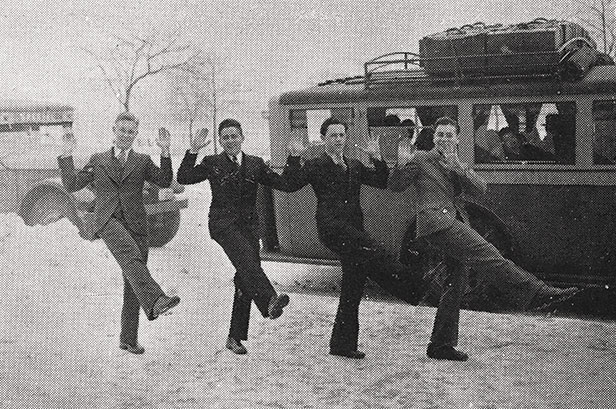The Tech Show Must Go On

In 1931, Paul Revere, Robinson Crusoe, and Red Riding Hood joined a chorus of men in skirts and high heels for MIT’s annual Tech Show. The production included “tuneful interludes,” varied scenes, and a healthy dollop of what would now be considered political incorrectness. It had the audience in stitches.
But the ‘31 show lost $1,200 (roughly $15,000 in 2011 dollars), and after a string of similar experiences, the coffers of the student-run production were empty. What had started as a fund-raising effort for MIT athletics in 1899 was no longer raising funds of any kind. The Undergraduate Association’s Institute Committee cancelled the show in 1932.
Paul Lappé ‘34, Harold “Hal” Bellinson ‘34, SM ‘39, and Irving Kusinitz ‘34, who had been freshman comrades-in-chorus in the 1931 production, did not take this lying down; they and other Tech Show veterans decided to revive the tradition in 1933. Lappé spearheaded the effort, serving as general manager. Their plan “provided for a Show to be produced in Walker Gymnasium, Junior Prom Week-end, on a budget of about $1,000,” he would later write in a report to the Institute. “At $1.00 admission and a three-day run, it was felt that the Show could be financially successful.”
The Institute Committee’s powerful Executive Committee disagreed, however; the best the show could get was “provisional recognition.” And even as the students’ plans moved forward, the Executive Committee declared its intent to stymie all MIT support.
The show proponents’ only hope was to persuade the rest of the Institute Committee to override the Executive Committee. Debate ensued. A vote was called. Although a majority favored the production, as Lappé later wrote, the chairman of the Executive Committee was “so adamant in his opposition to the Show that a member of the committee, declaring his desire to change his vote in favor of the Show, was ruled ‘out of order’ and the motion [not to revive the show] declared ‘passed.’”
A compromise was eventually reached: the show could continue if it raised $300 and incurred no further debt. “The shaky status of the Show coupled with the current depression made the collection of the bond seem so improbable that even the Show’s opponents readily agreed,” Lappé wrote.
Even with two loans from the assistant bursar, Delbert Rhind, the students were unable to meet the goal. But on February 15, the Institute Committee accepted their check for $265. “There were exactly four weeks before opening night,” wrote Lappé. “In those twenty-eight days it was necessary to put together the entire Show, build a stage and scenery, print a program, [and] sell over a thousand tickets.”
Somehow, the students pulled it off. On March 15, 1933, Fancy That! debuted. The show, a musical comedy based on life at a fictional version of MIT in “Bosstown,” poked fun at the Institute, describing it as a place where boys would “study from four to seven years to become salesmen of mythical electrical refrigerators.” It was a smashing success. “By Saturday night, every seat in the house had been sold—and 200 extra!” Lappé wrote.
The show cleared about $150. Although that didn’t come close to covering the nearly $3,000 deficit from years past, the Institute Committee forgave the show’s debts and reinstated it as an official activity at MIT.
In his post-mortem report, Lappé offered pragmatic advice. His confident conclusion: “Put on a clean, clever, collegiate show each year and Tech Show will continue to live and thrive for another thirty years—and more!”
But the Tech Show struggled after his departure, going into hibernation in 1937. It was roused 10 years later and continued until 1969. Students resurrected the show again in 1980, but no Tech Show has been produced since 1981’s I Scream Clone.
The friendship of Lappé, Bellinson, and Kusinitz, however, endured. The three met up at Club Med on St. Lucia in the summer of 1994 to celebrate turning 80. Today Lappé, 97, is still proud of his role in resurrecting the Tech Show. “It was a wonderful show that was run, and we had a very good time working on it,” he recalls.
Rhind summed up Lappé’s achievement in a 1933 letter to the dean of undergraduate education and student affairs: “Tech show was reborn this year solely through the efforts of Paul Lappé ‘34 and full credit for its success is due him.”
Keep Reading
Most Popular
Large language models can do jaw-dropping things. But nobody knows exactly why.
And that's a problem. Figuring it out is one of the biggest scientific puzzles of our time and a crucial step towards controlling more powerful future models.
The problem with plug-in hybrids? Their drivers.
Plug-in hybrids are often sold as a transition to EVs, but new data from Europe shows we’re still underestimating the emissions they produce.
How scientists traced a mysterious covid case back to six toilets
When wastewater surveillance turns into a hunt for a single infected individual, the ethics get tricky.
Google DeepMind’s new generative model makes Super Mario–like games from scratch
Genie learns how to control games by watching hours and hours of video. It could help train next-gen robots too.
Stay connected
Get the latest updates from
MIT Technology Review
Discover special offers, top stories, upcoming events, and more.